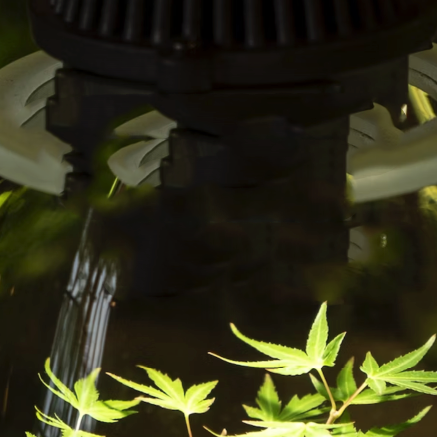Grow Lights - Intro Part 4: Lighting Area & Footprint
In our first 3 articles, we have taken a look at the hydroponics grow light spectrum and output intensity and how that affects plant growth. We looked specifically with regard to what they are and how we are going to measure them using a spectrometer and a professional PAR meter. Now we will move on to the 3rd aspect of consideration for a grow light - how well the light spreads out over the area in which you wish to grow your plants. This is also know as the "lighting footprint".
The four things that will affect this the most are likely to be:
a) What sort of light it is (HID such as HPS or MH, LED, fluorescent etc.)
b) The power of the grow light
c) The reflector (or in the case of an LED grow light, the lens)
d) How high the light is mounted above the canopy.
Most growers will want every square inch of their grow area to be as productive as possible. This means filling every corner of the space with a good level and ppfd of light.
In general, we need our grow lights to provide adequate light intensity, not just directly below the grow light but also around the edges of the the grow space too. It would also be preferable if the intensity is spread as evenly as possible without "hot-spots". Of course, with most grow lights, there will be positions (such as in the corners away from the grow light) where the intensity is probably going to be considerably lower than directly below the light. We can usually live (and grow) with this situation as long as the intensity is still adequate to produce decent results from the plants (or parts of the plants) that are growing at these furthest points.
At One Stop Grow Shop we generally recommend a 1m x 1m grow area for a 400 Watt HPS, a 1.2m x1.2m area for a 600 Watt HPS, and a 1.5m x 1.5m area for a 1000 Watt HPS. However, the grow light market is on the change, with truly viable LED grow lights and CDM grow lights of comparable grow potential appearing.
However, just because a grow light produces an impressive intensity right underneath it, it does not necessarily follow that plants out to the sides will be getting enough light to fulfil their potential.
For this reason, we decided to set up a test area so that we could see exactly how well a particular grow light illuminates the area underneath it.
We have created a dedicated testing area which has various marked testing points on it. The centre test point is directly below the lamp. The other test points are at 150mm (6 inch) intervals moving out from the centre in a square grid formation. The grid extends to 750mm (30 inches approx) either side and forward & behind of the centre. This is basically a 1.5 metre square test area. This should therefore be large enough to assess even a 1000 watt light system.
After that, we decided to conduct the test in an open area which we found gave us highly consistent results which could actually be used to get meaningful data for comparisons between different types of grow lights and reflectors etc.
In order to keep the testing consistent and fair, it was decided to mount every light (perfectly level of course) at 500mm (just under 20 inches). Before proper testing is to commence, the grow light will then be slowly adjusted forwards and backwards until maximum intensity (using the Li-Cor PAR meter) is seen at the centre test point. The ppfd (in umol/m2/s) will then be read at every test point in the area and the readings recorded on paper in the grid format as it is laid out on the ground.
Most growers will enclose their grow space with a grow tent or will hang reflective sheeting. Originally, we set up the test area inside a grow tent with a reflective lining. However, as soon as we began testing we noticed we could not get consistent and repeatable results. This was because even small shifts in the fabric of the tent, which could be caused by doing something relatively minor like closing and zipping the doors, ended up changing the readings.
Although we attempted to minimise this as much as possible, we finally had to admit to a lack of confidence in the results when someone walked past the grow tent and the resulting breeze caused the reading being taken at that moment to completely alter! We realise that savvy growers will always utilise reflective sheeting around the outside of the grow space because doing so will inevitably give remarkably better results, particularly around the edges of the grow space. However, we finally decided to do the testing in an open space with no reflective walls. Although we know this is not how a a grow light will be typically used, it still gives us a useful idea of how well a grow light will perform and how good its spread of light is.
It is a little tricky to pinpoint exactly what amount is required for substantial yields. However, many growers around the internet guesstimate a minimum amount of around 200 umols/m2/s for the 12 hour day. Plant leaves can use usually at least 600 umols/m2/s. A perfectly healthy leaf may be able to utilise up to as much as 1500 umols/m2/s. However, the utilisation is not linear. There will be diminishing returns after a certain point, usually at around 800-1000 umols. The limitations on photosynthesis and growth thereafter will be more to do with the rate that CO2 can be respired.
